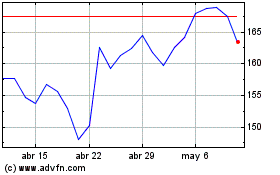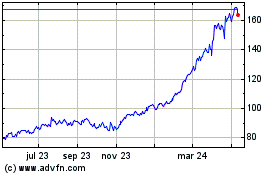Core power unit posts another weak quarter, but stock rises at
lack of negative surprises
By Thomas Gryta
This article is being republished as part of our daily
reproduction of WSJ.com articles that also appeared in the U.S.
print edition of The Wall Street Journal (February 1, 2019).
General Electric Co. executives said they were making progress
in turning around the troubled conglomerate, after the company
reported another quarter of weak profits in its core power business
and legacy problems in its GE Capital unit.
Larry Culp, who took over as chief executive in October, warned
that fixing the power unit would take time and he declined to
provide detailed financial targets for the new year.
"2019 still very much work in progress but the company is
becoming stronger," Mr. Culp said in a conference call Thursday. He
said he expected the company's industrial revenues to rise this
year, with gains in most units and declines in power.
Mr. Culp cautioned the company's cash flow in 2019 would be
impacted by restructuring, charges related to its power business,
investments in its health-care spinoff and other one-time items. He
said he expected cash flow to grow substantially in 2020 and
2021.
While GE's quarterly results were weak compared with peers and
executives avoided committing to specific targets for the year
ahead, the lack of setbacks was positive.
"I think for a number of investors, the absence of yet another
negative surprise is perhaps very much a part of the story," Mr.
Culp said in an interview Thursday.
Shares of GE closed 11.65% higher at $10.16, marking the stock's
biggest single-day percentage gain in a decade. The shares have
rallied more than 50% from their low in December but are still
trading below where they were when Mr. Culp took over and 35% below
where they stood a year ago.
GE plans to provide financial projections at some point when it
has enough confidence in its operations.
"I'm not going to put the company's reputation at further risk
by satisfying an artificial calendar in that regard," Mr. Culp
said. "We are going to come out with guidance when we can walk
people through it, where the math adds up, and we can be very clear
on how we are going to go about delivering on those numbers."
Mr. Culp said the company aims to reduce its leverage by $50
billion from selling off its transportation division, selling down
its stake in oil-services firm Baker Hughes and the initial public
offering of the health-care business. He said GE doesn't plan to
sell its Gecas plane-leasing business, which several private-equity
firms have expressed interest in buying.
GE expects to contribute $4 billion to GE Capital this year. It
also agreed to pay $1.5 billion to settle a long-running
investigation by the Justice Department into a defunct
subprime-mortgage business called WMC.
The government was investigating whether the business violated
federal lending laws as part of a larger probe into the subprime
mortgage crisis. The charge was in line with the amount GE had
previously set aside for a potential settlement.
The fourth-quarter profit attributable to GE was $761 million,
compared with a loss of $10.82 billion a year earlier, when it
booked a large charge for a shortfall in reserves at a defunct GE
Capital insurance business.
GE finance chief Jamie Miller said GE still expects to pay $2
billion into reserves this year. An annual review should be
finished in mid- to late February, she said, but no changes are
expected.
Last year, GE surprised investors when it revealed it was still
on the hook for the policies, which provide coverage for nursing
home stays and other care, and it would need to bolster reserves by
$15 billion over seven years.
Revenue rose 5% to $33.28 billion, including a 25% decline in
power business, which makes turbines for power plants, and a 21%
jump in its aviation business, which manufactures jet engines.
Those are the two biggest units that will be the core of the
company after it moves ahead with plans to break itself apart
following a difficult two years.
Cash flow from operations was $6.4 billion for the quarter, down
9% from last year. The fourth quarter is typically the strongest
for GE. Full-year cash flow from operations dropped 80% to $2.3
billion from $11 billion in 2017.
On the conference call, GE said its goals were to attain a A
credit rating and return to a dividend payment "in line with peers
over time." Investors have been nervous about GE's credit rating,
which was downgraded two notches last year to BBB by the major
credit-rating firms. The company has twice in the past 18 months
cut its once generous dividend.
The power division, which had been GE's biggest in terms of
revenue, has been at the center of GE's financial and operational
woes. The pain continued in the fourth quarter with a segment loss
of $872 million, which GE said came from "continued execution and
operational issues." The company is reviewing every power project
and contract, but said the work will take time.
The company's aviation business continued to outshine the other
operations -- segment profit was higher than all others combined --
as demand for its jet engines remained strong from plane makers
Boeing Co. and Airbus SE. Profit rose 24% to $1.7 billion in the
quarter on revenue of $8.5 billion.
The other major GE business, health care, showed little growth
as profit rose 2% to $1.18 billion and revenue grew 2% to $5.4
billion in the quarter.
The company did provide some directional projections for 2019,
expecting industrial revenue to rise in the low to mid-single
digits. The Power division will have another down year as the
overall market remains slow.
In aviation, 75% to 80% of commercial engine sales are locked in
through existing orders along with services revenue of $15 billion.
Overall, the division expects high-single-digit revenue growth and
low single-digit profit growth.
Despite settling the mortgage-related investigation, Mr. Culp
still must contend with continuing government probes into GE's
accounting. Both the Justice Department and the Securities and
Exchange Commission are investigating GE's revenue recognition of
service contracts in its power business, a $22 billion charge
booked in the third quarter and the process that uncovered the
insurance shortfall.
"It is very hard to predict how long some of these other
investigations are likely to take," Mr. Culp said. GE has
previously denied wrongdoing, and Mr. Culp said it is cooperating
with the investigations.
"We would certainly like to wrap up anything of that nature
sooner rather than later," he said. "But those investigations tend
to go on for extended periods of time. We've been through them
before."
Write to Thomas Gryta at thomas.gryta@wsj.com
(END) Dow Jones Newswires
February 01, 2019 02:47 ET (07:47 GMT)
Copyright (c) 2019 Dow Jones & Company, Inc.
GE Aerospace (NYSE:GE)
Gráfica de Acción Histórica
De Mar 2024 a Abr 2024

GE Aerospace (NYSE:GE)
Gráfica de Acción Histórica
De Abr 2023 a Abr 2024
